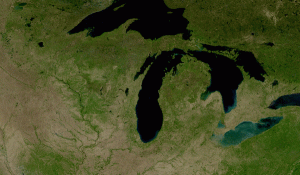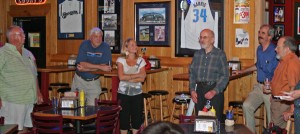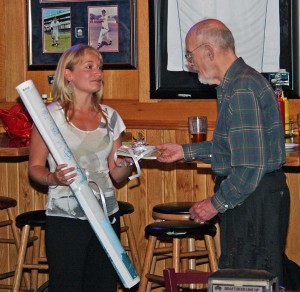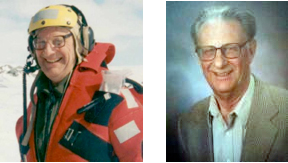Monthly News Summary – July 2010
- BRDF Software Package Released by SSEC and Boston University
- CIMSS’ Successful Re-Competition Proposal
- ICDS Celebrates 10th Anniversary in the Ice Drilling Business
- Kossin Assumes Additional Lead Authorship Duties for IPCC
- CIMSS Summer Workshop for High School Students
- Suomi Proclaimed “Pragmatic Visionary” in Comprehensive BAMS Article
- IN MEMORIAM – Charles R. Stearns
BRDF Software Package Released by SSEC and Boston University
The UW-Madison SSEC and Boston University released a software package that uses MODIS direct broadcast data to create a Bidirectional Reflectance Distribution Function (BRDF)/Albedo product. The BRDF product models what the land surface would look like in the absence of clouds and the effects of scattering from atmospheric molecules and the surface due to different viewing and solar geometries.
The software collects 16 days of data for each grid point with views from differing satellite and viewing angles to get a good model of the distribution of reflectances. The final product is a modeled reflectance of what the surface would truly look like with no atmosphere (including clouds), and a nadir view at each point.
An example of the type of imagery that can be produced from the modeled nadir reflectances displayed in a true color imagery loop that covers 40 days from May 12 through June 21, 2010. This loop has one image for every 8 days and shows the greening of the Midwest that occurred over this time period. The BRDF data and images were created from MODIS data collected from the SSEC X-band antenna.
This is a very important step forward for direct broadcast in that it is the first product that is created on the MODIS land tiling system, which breaks the earth up into a set of grid pieces. This complicates the porting and packaging of the software for use on a local, rather than global scale. MODIS BRDF/Albedo also serves as a required input to all of the other official NASA MODIS land products, thus opening the door for other land products to be packaged and distributed in the future.
Both source and binary software are included in this release. This release has been tested on both 32- and 64-bit Linux platforms and the statically linked 32-bit binary executables should work with most flavors of Linux. There are also “Make” files that can be used to compile the software locally.
The DB BRDF software was provided by Dr. Crystal Schaaf and Dr. Yanmin Shuai of Boston University.
The software can be downloaded through the IMAPP web site.
submitted by Kathy Strabala
CIMSS’ Successful Re-Competition Proposal
Be sure to check out this month’s “Folly,” supplied by Tom Achtor, for a good look at the process and the prodigious effort that resulted in a successful re-competition proposal.
We have just been notified that we were successful in our re-competition proposal to keep CIMSS at the University of Wisconsin-Madison! It is a 5 year, $60 million proposal. We were, and continue to be, successful because of all the excellent work done by many, many people.
ICDS Celebrates 10th Anniversary in the Ice Drilling Business
Ice Coring and Drilling Services (ICDS) and Ice Drilling Design and Operations (IDDO) hosted a reception to celebrate the 10th Anniversary of their work with the National Science Foundation (NSF) and to reward the hard working staff, acknowledge the great people that provide them with support, and to thank everyone that has helped ICDS succeed.
Professor Emeritis Charles Bentley tells tales from 50 years of Antarctic exploration.
Kristina Dahnert presents Charles Bentley with souvenir maps (new and old) of Antarctica and a half-century old issue of National Geographic magazine with an article featuring Antarctic projects.
After its initial experience designing and developing hot water drills for the Antarctic Muon and Neutrino Detector Array (AMANDA) and IceCube projects, ICDS moved on to drilling assignments that ranged from Tibet to Alaska and, of course, Antarctica and Greenland.
ICDS designed and built the Deep Ice Sheet Coring (DISC) drill to obtain high quality ice cores continuously from the surface to a depth of at least 3,800 meters. The DISC drill system is capable of collecting replicate cores from depth intervals of special interest. Other science requirements include the ability to core ice at the pressure melting point, to minimize the number of core fragments, and to determine the core orientation.
ICDS provides support for NSF-sponsored cold-regions research in both polar regions and at high altitudes. ICDS maintains and operates existing equipment, and develops new systems dedicated to:
- providing high quality ice cores, and
- producing boreholes that provide access to the interior and beds of ice sheets and glaciers for such purposes as embedding instruments, collecting gas samples, setting seismic charges, and studying subglacial processes.
Kossin Assumes Additional Lead Authorship Duties for IPCC
James Kossin has been selected as a Lead Author of Chapter 14 “Climate Phenomena and their Relevance for Future Regional Climate Change” in the Working Group I contribution to
Fifth Assessment Report (AR5) of the Intergovernmental Panel on Climate Change (IPCC).
The IPCC, jointly sponsored by the World Meteorological Organization (WMO) and the United Nations Environment Program (UNEP), is a global organization created to assess the major scientific and technical issues confronting governments concerning climate change. In 2007 the IPCC and Vice-President Al Gore Jr. were awarded the Nobel Peace Prize “for their efforts to build up and disseminate greater knowledge about man-made climate change, and to lay the foundations for the measures that are needed to counteract such change.”
Previously, Kossin was named a Lead Author of the IPCC Working Group II (Impacts, Adaptation, and Vulnerability), Special Report on “Managing the Risks of Extreme Events and Disasters to Advance Climate Change Adaptation”.
CIMSS Summer Workshop for High School Students
The Cooperative Institute for Meteorological Satellite Studies (CIMSS) held the 18th offering of its high school Workshop for Atmospheric, Earth, and Space Sciences on the University of Wisconsin-Madison campus, 20-24 June 2010. The workshop included field trips to a local television station (WKOW-TV), a private weather company (Weather Central), the nearby NOAA National Weather Service (NWS) forecast office in Sullivan, WI, the Baraboo Range for a geological tour, and Lake Mendota for a limnology dredging expedition.
Twelve students participated this year, with three traveling from out of state. Numerous presentations were given on a variety of science topics, with an emphasis on weather and satellite remote sensing. NOAA Advanced Satellite Products Branch (ASPB) members provided significant contributions: Robert Aune on using computers to forecast the weather, Tim Schmit on the Geostationary Operational Environmental Satellite (GOES) program, and Gary S. Wade on the Man computer Interactive Data Access System (McIDAS), with use of the latest version – McIDAS-V – for hands-on lab sessions.
Suomi Proclaimed “Pragmatic Visionary” in Comprehensive BAMS Article
The May 2010 issue of the Bulletin of the American Meteorological Society (BAMS) contains an in-depth analysis of the life and work of Professor Verner Suomi entitled “Suomi: Pragmatic Visionary” by John M. Lewis, David W. Martin, Robert M. Rabin, and Hans Moosmuller.
John Lewis touched on some of this material when he spoke at the 50th anniversary celebration of the launch of Explorer VII last fall.
IN MEMORIAM – Charles R. Stearns
Professor Charles R. Stearns (1925-2010) passed away on Tuesday, June 22, 2010. He recently celebrated his 85th birthday. Dr. Stearns was a professor in the Department of Atmospheric and Oceanic Science and Senior Scientist at the Space Science and Engineering Center, both at the University of Wisconsin-Madison. He was born in McKeesport, Pennsylvania and graduated in 1943 from J. Sterling Morton High School in Cicero, Illinois, where he also attained the rank of Eagle Scout.
His association with the University of Wisconsin spanned a period of over 67 years. He was an undergraduate student at the University from 1943 to 1950 earning a Bachelor of Science in Physics. During this period, he served in the United States Army (1943-1946) and fought in the Leyte and Okinawa campaigns. He was awarded a combat infantryman badge, bronze star with oak leaf cluster, and Presidential Unit Citation for extraordinary heroism. He served as platoon leader during the last month of the invasion of Okinawa and was promoted to technical sergeant upon discharge.
Stearns graduated with his Master of Science degree in Meteorology in 1952, and spent some time farming outside of Madison. He later returned to graduate school and received his Doctorate of Philosophy in 1967 in Meteorology. He briefly spent a year as Chief Physicist at Winzen Research, Inc., in Minneapolis, Minnesota, 1956-1957. He served as a member of the faculty since 1965, and was chairman of the Instructional Program for the Institute for Environmental Studies, 1972-1974.
Stearns taught many classes during his career including micrometeorology, meteorological instrumentation, weather and climate, and atmospheric dispersion/air pollution. He was involved in over numerous field projects including surface modification experiments, micrometeorology of the Pampa de La Joya in Peru, Cooperative Field Experiment in Davis California, Lake Wingra International Biological Program, Portage Power Plant Dispersion monitoring, Washington Island Wind Energy monitoring and Greenland Automatic Weather Stations Project.
He was advisor to 30 students over his career, and provided significant assistance to a half dozen other students in the US and abroad with their research.
He was the principal investigator of the Antarctic Automatic Weather Station (AWS) Program from 1980 to 2008. The AWS project was the first large-scale meteorological instrumentation placed on the Antarctic continent. He deployed to Antarctica 18 times.
In 1982 he was awarded the Antarctic Service Medal by the National Science Foundation for his scientific achievement under the US Antarctic Research Program. In 1992, he developed a method for the generation of satellite composite imagery over the Antarctic continent and adjacent Southern Oceans still used in forecasting, research and education.
He was elected a fellow of the American Meteorological Society in 2004. He will be awarded the Goldthwaite Polar Medal posthumously at the 5th Antarctic Meteorological Observation, Modeling and Forecasting Workshop in Columbus, Ohio on July 12, 2010.
Charles R. Stearns was intrigued by the untamed quality of nature and science and was fond of this saying: “Mother nature always bats last.”
There will be a celebration of Professor Stearns’ career at the 5th Antarctic Meteorological Observation, Modeling, and Forecasting Workshop July 12- 14 at Byrd Polar Research Center, Ohio State University.
The Antarctic Sun has published a brief article regarding Professor Stearns.
Share Your Memories of Chuck Stearns
In addition, there is a now an online site to leave remembrances and stories about Professor Stearns.




